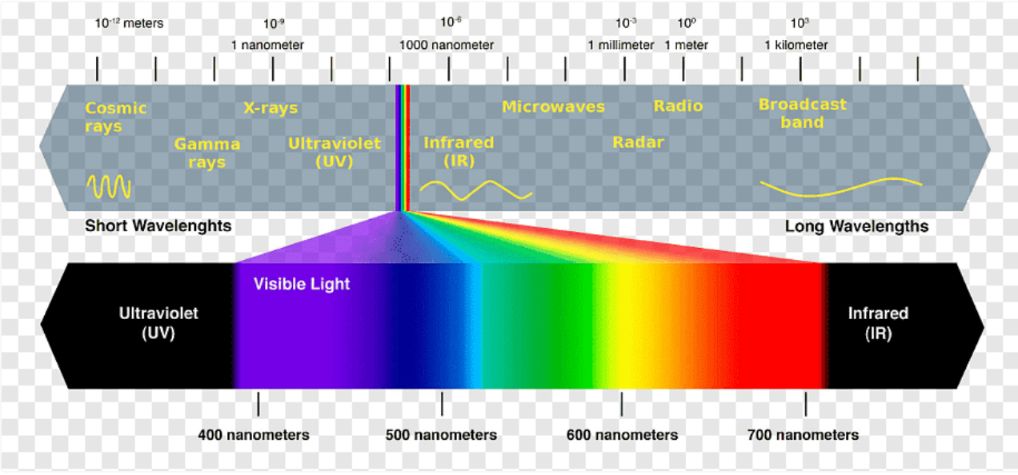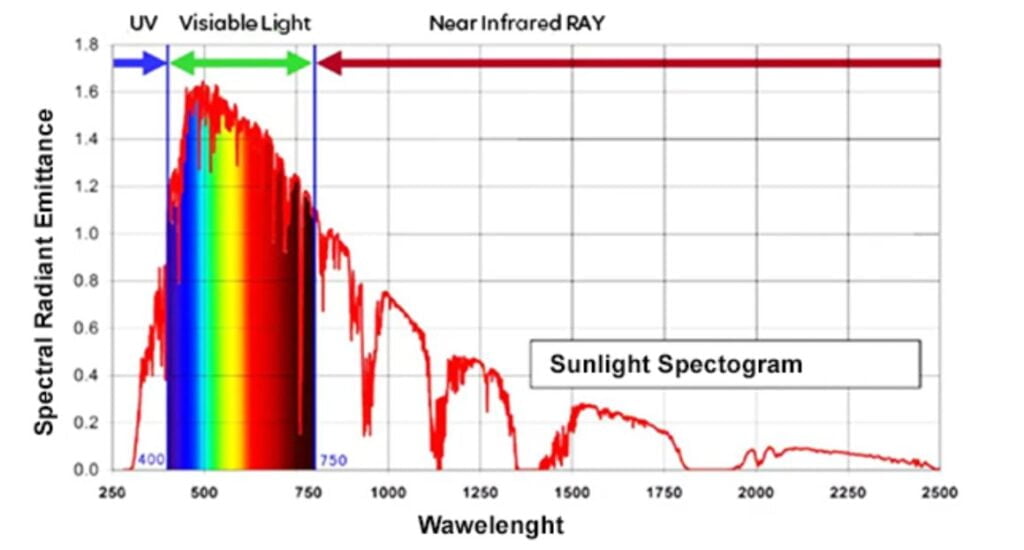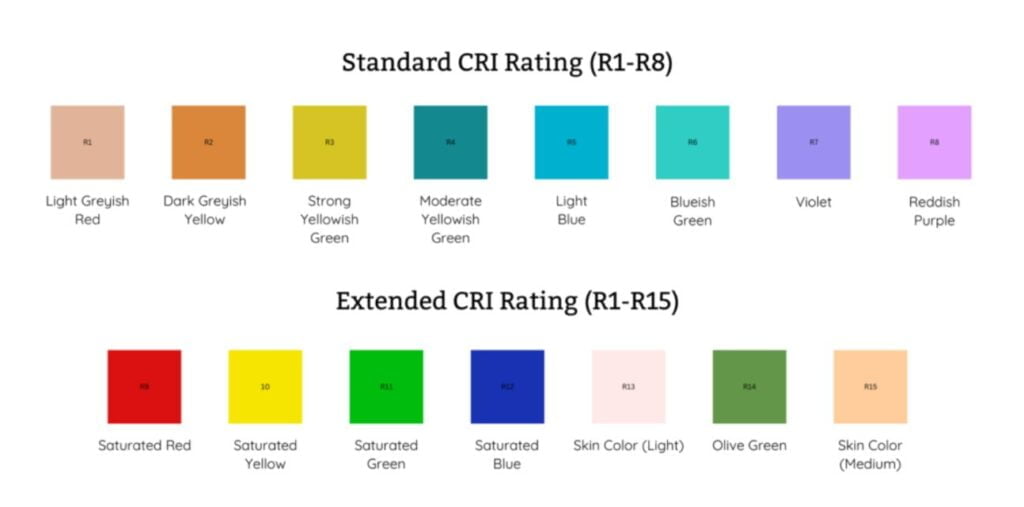What Is CRI? Everything About Color Rendering Index
Table of Contents
The Color Rendering Index (CRI) is widely used as a standard for gauging the accuracy with which a given light source reproduces colors. CRI is employed in various situations, including residential, commercial, and industrial applications, and is crucial to producing accurate and natural-looking colors in lighting design. As LED lighting becomes more commonplace, knowledge of CRI becomes more important for choosing lights that accurately reproduce colors.
This article will walk you through all you need to know about the CRI, making it much simpler to comprehend and utilize this significant measure in your work. We will discuss the thought process behind CRI, how it is computed, and the benefits and drawbacks of utilizing this statistic. In addition, we will review the process of measuring CRI, how to properly interpret the results, and how to choose lighting equipment per CRI specifications. The common misunderstandings about CRI, LEDs’ impact on CRI, and the connection between CRI and sustainability will also be discussed. In the final part of this discussion, we will investigate the most recent advancements in CRI measurement and technology and discuss some potential applications for these tools in the near and distant future. This tutorial will help you learn about CRI and how it influences the quality of light so that you can make better purchases, regardless of whether you are an experienced lighting professional or a customer.

What is the Color Rendering Index (CRI)?
The Color Rendering Index (CRI) is a quantitative statistic that assesses how accurately various light sources reproduce colors. The color rendering index (CRI) is an important number to have when designing lighting systems that accurately display colors. This is especially important in environments where color accuracy is absolutely necessary, such as in photography, art galleries, and medical facilities. The color rendering index, or CRI, is calculated on a scale that ranges from 0 to 100, with higher values indicating more accurate color reproduction.
The CRI is determined by comparing the color rendering of a light source to that of a reference light source with the same color temperature. The CRI measurement considers the appearance of various colors and how they appear under different light sources, ensuring that colors are not distorted or skewed by the lighting.
Color Rendering Index (CRI) is a measurement represented by a maximum score of 100, indicating the ability of a light source to render colors accurately. CRI is evaluated on a scale, with higher numbers denoting better color rendering ability. Like test scores, the CRI measurement is a convenient metric that a single, quantified number can represent.
An excellent CRI score is 90 and above, indicating that the light source can render colors with a high degree of accuracy. Conversely, scores below 80 are generally considered poor and may result in colors appearing distorted or unnatural.
Importance of Color Accuracy: The Role of CRI
The Color Rendering Index (CRI) is a measurement and comparison tool that analyzes how the color of an object changes depending on whether it is being viewed in natural or artificial light. This measurement is critical in environments where color accuracy is of the utmost importance, such as in retail stores or art galleries, where the true color of things must be displayed strictly to maintain high customer satisfaction.

For example, a red shirt displayed under a light with a low CRI measurement may appear dull or faded, whereas the same shirt under a light with a high CRI measurement will appear vibrant and true to color. Similarly, a painting displayed under lighting with a low CRI may appear washed out, while a painting under high CRI lighting will display the colors more accurately.

The CRI measurement ensures that colors are not distorted or skewed by the lighting source, enabling lighting professionals and consumers to select lighting products that provide natural-looking color reproduction. Therefore, the CRI is an essential consideration in lighting design and product selection, ensuring that the colors of objects are accurately displayed under artificial lighting.

How is CRI measured?
The Color Rendering Index (CRI) is tested using a specific method that involves measuring the spectrum of the light source in question and algorithmic calculations. To calculate CRI, you have to compare the light source in question to a standard daylight spectrum, which is used as a point of comparison.
Spectral readings are used to determine the light source’s color temperature, which is the first step in the process. This is done to choose the right range of daylight to compare with. Once the color temperature is known, the light source is used to shine virtually on a set of virtual color swatches called test color samples (TCS).
Then, the TCS’s mirrored color is measured and compared to the color of the same swatch in reference daylight. The color variations are counted, and the CRI is found by taking the average of those numbers.
There are 15 different color samples in total:

What Are The Most Usual CRI Values, And What Is Good?
An 80 CRI (Ra) score is considered the minimum requirement for acceptable color rendering in most indoor and commercial lighting settings. However, a CRI score of 90 (Ra) or higher is recommended when color accuracy is critical for work or aesthetic reasons. Such lighting options are generally referred to as high CRI lights.
Industries that require 90 CRI or above for work-related purposes may include textile factories, hospitals, paint shops, and printing facilities. On the other hand, high-end hotels, retail stores, photography studios, and residential spaces are areas where improved aesthetics may be a significant factor.
When comparing lighting products with a CRI score above 90, it is essential to analyze the individual R values contributing to the CRI score, particularly CRI R9. This practice can provide a more precise understanding of how well the light source renders red colors, impacting the accuracy of skin tones and other red objects.
CRI and LEDs
As LED lighting becomes more prevalent, it is important to understand its impact on Color Rendering Index (CRI). CRI measures a light source’s ability to reveal colors accurately compared to natural light. LED lights can have varying CRI scores, which can impact the appearance of objects under their illumination.
The impact of LED lighting on CRI can be significant. Many early LED lighting products had low CRI scores, resulting in washed-out or inaccurate colors. However, LED technology has improved, and now high-CRI LED lighting options are available.
To ensure high CRI in LED lighting, it is important to consider the specific LED product’s CRI score. CRI scores of 90 and above are considered high, and products with these scores are ideal for applications where color accuracy is crucial, such as in photography studios or art galleries.
LED lighting trends can also impact CRI. For example, the trend towards “warm” LED lighting can impact CRI scores, as warmer lighting temperatures typically have lower CRI scores. Therefore, it is important to consider both the CRI score and the color temperature when selecting LED lighting products.
Conclusion
The Color Rendering Index (CRI) is a measurement that determines how well different light sources reproduce colors. It is an essential parameter for lighting design and the selection of products. It is of utmost significance in environments where accurate color representation is necessary, such as retail stores, art galleries, and medical institutions. Scores above 90 are considered outstanding, whereas scores below 80 are generally considered poor.
A higher CRI score implies a greater ability to portray colors. Knowing the color rendering index (CRI) is vital for choosing lights that faithfully reproduce colors as LED lighting becomes more widespread. When evaluating different lighting products, lighting experts and consumers should pay attention to the CRI score and individual R values, paying special attention to the CRI R9 value. This will ensure that the goods offer more natural color reproduction.
FAQs
Yes, CRI can influence the mood of a room because light quality impacts how we perceive colors and textures. A light source with a high CRI creates a more natural, comfortable atmosphere, while a low CRI may make a space feel unnatural or flat, which can affect the overall ambiance.
CRI is important because it affects how colors are perceived under artificial lighting. A high CRI (90 or above) ensures that colors appear vibrant and true to life, which is essential in settings like art studios, kitchens, or retail spaces where color accuracy is crucial.
A good CRI for most applications is 80 or above. For areas where color accuracy is especially important, such as in photography, makeup application, or design work, look for a CRI of 90 or higher.
No, CRI measures the color accuracy of light, not its brightness. Brightness is determined by the light’s lumen output, while CRI focuses on how well the light renders the true colors of objects.
Yes, many modern LED lights have high CRI ratings, often ranging from 80 to 95 or higher. If color accuracy is important for your space, look for LED lights specifically labeled with a high CRI to ensure the best color rendering.

Hi, I’m Xylia Xiong, a sales professional with 14 years of experience in the LED strip light industry. I specialize in providing tailored solutions, leveraging my expertise in LED products and the latest industry trends. Known for effective communication and problem-solving, I’m dedicated to helping lighting manufacturers, importers, and distributors achieve their goals.
Let’s work together to create customized solutions that exceed expectations.
Related Posts

The Best LED Strip Lights You Can Buy Right Now

Comparing WS2811 Vs WS2812B: Key Differences


